
Eugène Henri Paul Gauguin was a French Post-Impressionist artist. Unappreciated until after his death, Gauguin is now recognized for his experimental use of color and Synthetist style that were distinct from Impressionism. Toward the end of his life, he spent ten years in French Polynesia. The paintings from this time depict people or landscapes from that region.

Papeete is the capital city of French Polynesia, an overseas collectivity of the French Republic in the Pacific Ocean. The commune of Papeete is located on the island of Tahiti, in the administrative subdivision of the Windward Islands, of which Papeete is the administrative capital. The French High Commissioner also resides in Papeete.

With its 320 square kilometres, Hiva Oa is the second largest island in the Marquesas Islands, in French Polynesia, an overseas territory of France in the Pacific Ocean. Located at 9 45' south latitude and 139 W longitude, it is the largest island of the southern Marquesas group. Around 2,200 people reside on the island. A volcano, Temetiu, is Hiva Oa's highest point with 1,200 metres.
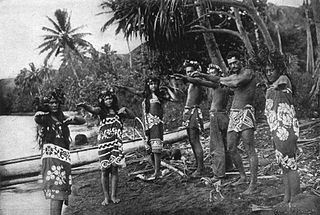
The Marquesas Islands were colonized by seafaring Polynesians as early as 300 AD, thought to originate from Samoa. The dense population was concentrated in the narrow valleys and consisted of warring tribes.
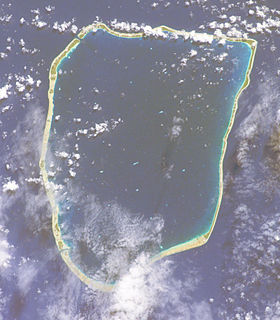
Apataki is a coral atoll in the South Pacific Ocean, territorially part of French Polynesia. It is one of the Palliser Islands, a subgroup of the Tuamotu Archipelago. Apataki is located approximately 370 kilometres northeast of the island of Tahiti, 17 km (11 mi) east of Arutua and 24 km (15 mi) northeast of Kaukura. The island is approximately rectangular; it is 34 km (21 mi) long and 24 km (15 mi) wide. It has a total area of approximately 706 km2 with a land area of approximately 21 km2 (8 sq mi). Two navigable passes enter its wide lagoon.

Punaauia is a commune in the suburbs of Papeete in French Polynesia, an overseas territory of France in the Pacific Ocean. Punaauia is located on the island of Tahiti, in the administrative subdivision of the Windward Islands, themselves part of the Society Islands. In the late 1890s, the French painter Paul Gauguin lived in Punaauia. Here he painted his masterpiece Where Do We Come From? What Are We? Where Are We Going?. The commune borders Faaa on the north and Paea on the south.
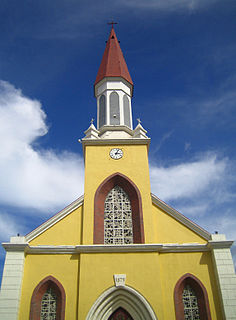
Notre Dame Cathedral is a late 19th-century church that serves as the cathedral of the Roman Catholic Archdiocese of Papeete. It is located close to the waterfront esplanade of the capital city on the rue du Général de Gaulle.

The Paul Gauguin Museum is a Japanese-styled art museum dedicated to the life and works of Paul Gauguin in Tahiti, French Polynesia. The Museum is closed for renovations - but the sister museum in Hiva Oa is open.

Marquesas swamphen is a presumably extinct species of swamphen from the Marquesas Islands Hiva Oa and Tahuata. It was originally described from 600-year-old subfossil remains from Tahuata and Hiva Oa. It may have survived to around 1900; in the lower right corner of Paul Gauguin's 1902 painting Le Sorcier d'Hiva Oa ou le Marquisien à la cape rouge there is a bird which resembles native descriptions of Porphyrio paepae. Thor Heyerdahl claimed to have seen a similar flightless bird on Hiva Oa in 1937.
Events from the year 1888 in France.

This page list topics related to French Polynesia.

Oviri is an 1894 ceramic sculpture by the French artist Paul Gauguin. In Tahitian mythology, Oviri was the goddess of mourning and is shown with long pale hair and wild eyes, smothering a wolf with her feet while clutching a cub in her arms. Art historians have presented multiple interpretations—usually that Gauguin intended it as an epithet to reinforce his self-image as a "civilised savage". Tahitian goddesses of her era had passed from folk memory by 1894, yet Gauguin romanticises the island's past as he reaches towards more ancient sources, including an Assyrian relief of a "master of animals" type, and Majapahit mummies. Other possible influences include preserved skulls from the Marquesas Islands, figures found at Borobudur, and a 9th-century Mahayana Buddhist temple in central Java.

The Tahitians, are the Indigenous Polynesian people of Tahiti and thirteen other Society Islands in French Polynesia, as well as the modern population of these lands of multiracial, primarily Polynesian-French, ancestry. Indigenous Tahitians are one of the largest Polynesian ethnic groups, behind the Māori, Samoans and Hawaiians.
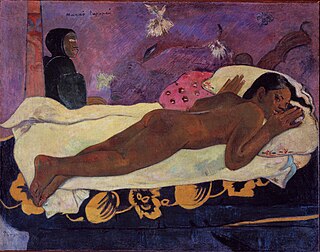
There was widespread belief in ghosts in Polynesian culture, some of which persists today. After death, a person's ghost would normally travel to the sky world or the underworld, but some could stay on earth. In many Polynesian legends, ghosts were often involved in the affairs of the living. Ghosts might also cause sickness or even invade the body of ordinary people, to be driven out through strong medicines.

Spirit of the Dead Watching is an 1892 oil on burlap canvas painting by Paul Gauguin, depicting a nude Tahitian girl lying on her stomach. An old woman is seated behind her. Gauguin said the title may refer to either the girl imagining the ghost, or the ghost imagining her.

Fatata te Miti is an 1892 oil painting by French artist Paul Gauguin, located in the National Gallery of Art, in Washington, DC.

Soyez amoureuses vous serez heureuses is a bas-relief wood panel carved and polychromed by French artist Paul Gauguin in the autumn of 1889. Gauguin depicts himself in the upper right, sucking his thumb and grasping the hand of the fleshy nude woman, a Polynesian or African, who seems to recoil in fear.

The Tahitian Dog is an extinct breed of dog from Tahiti and the Society Islands. Similar to other strains of Polynesian dogs, it was introduced to the Society Islands and Tahiti by the ancestors of the Tahitian (Mā’ohi) people during their migrations to Polynesia. They were an essential part of traditional Tahitian society; their meat was included in Tahitian cuisine and other parts of the dog were used to make tools and ornamental clothing. Dogs were fed a vegetarian diet and served during feasts as a delicacy. European explorers were the first outsiders to observe and record their existence, and they were served to early explorers including Captain James Cook. The Tahitian Dog disappeared as a distinct breed after the introduction of foreign European dogs.
Today the term South Seas, or South Sea, is used in several contexts. Most commonly it refers to the portion of the Pacific Ocean south of the equator. In 1513, when Spanish conquistador Vasco Núñez de Balboa coined the term Mar del Sur, or South Sea, the term was applied to the entire area of today's Pacific Ocean. In 1520 Ferdinand Magellan named the same ocean the Pacific Ocean, and over time Magellan's name became dominant. The South Sea term was retained, but was applied only to southern areas of the Pacific.
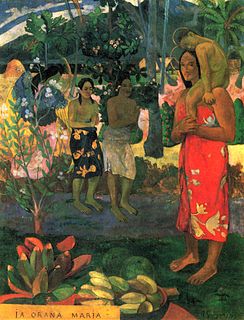
Ia Orana Maria is an 1891 oil on canvas painting by Paul Gauguin, now in the Metropolitan Museum of Art. It is one of the first works in his Tahitian period and shows two Polynesians (centre) greeting the Madonna and Child.

















